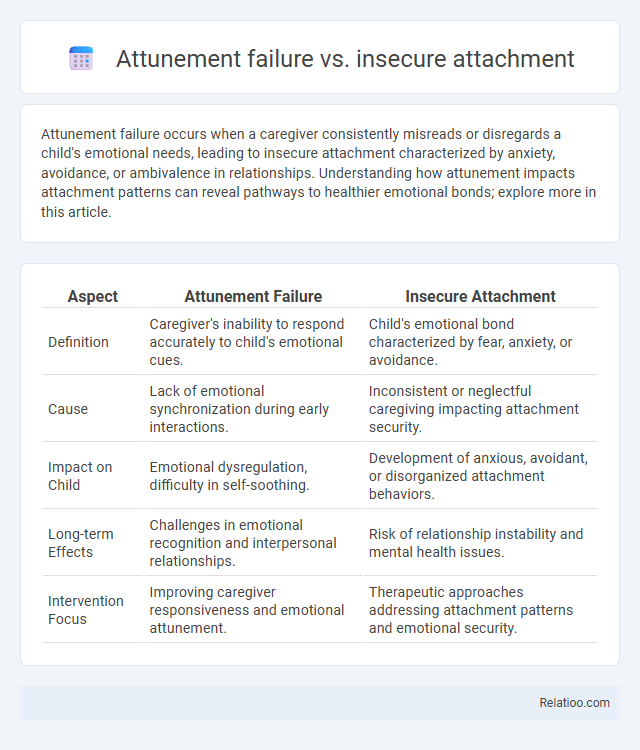Attunement failure occurs when a caregiver consistently misreads or disregards a child's emotional needs, leading to insecure attachment characterized by anxiety, avoidance, or ambivalence in relationships. Understanding how attunement impacts attachment patterns can reveal pathways to healthier emotional bonds; explore more in this article.
Table of Comparison
| Aspect | Attunement Failure | Insecure Attachment |
|---|---|---|
| Definition | Caregiver's inability to respond accurately to child's emotional cues. | Child's emotional bond characterized by fear, anxiety, or avoidance. |
| Cause | Lack of emotional synchronization during early interactions. | Inconsistent or neglectful caregiving impacting attachment security. |
| Impact on Child | Emotional dysregulation, difficulty in self-soothing. | Development of anxious, avoidant, or disorganized attachment behaviors. |
| Long-term Effects | Challenges in emotional recognition and interpersonal relationships. | Risk of relationship instability and mental health issues. |
| Intervention Focus | Improving caregiver responsiveness and emotional attunement. | Therapeutic approaches addressing attachment patterns and emotional security. |
Understanding Attunement Failure
Attunement failure occurs when caregivers consistently misread or respond inappropriately to an infant's emotional cues, disrupting the development of secure attachment. Unlike insecure attachment, which can arise from various caregiving inconsistencies, attunement failure specifically undermines emotional synchronization critical for healthy relational bonds. Understanding attunement failure involves recognizing its impact on neural pathways responsible for emotional regulation and trust formation, highlighting the necessity of sensitive and responsive caregiving in early development.
Defining Insecure Attachment
Insecure attachment is characterized by inconsistent or unresponsive caregiving that leads to difficulty in forming stable and trusting relationships. Unlike attunement failure, which specifically involves a caregiver's inability to accurately perceive and respond to a child's emotional needs, insecure attachment reflects a broader pattern of relational challenges stemming from neglect or unpredictability. Your understanding of insecure attachment can help identify patterns of emotional insecurity and prioritize interventions that foster emotional safety and reliable attunement in relationships.
Key Differences Between Attunement Failure and Insecure Attachment
Attunement failure occurs when caregivers consistently misinterpret or respond inappropriately to a child's emotional cues, leading to disrupted emotional communication, whereas insecure attachment describes the child's resulting maladaptive attachment style marked by anxiety, avoidance, or ambivalence. Attunement failure is a caregiver-driven process, focusing on moment-to-moment interaction quality, while insecure attachment reflects the child's internal working models of relationships formed over time from these interactions. The key difference lies in attunement failure being a micro-level interactional breakdown, and insecure attachment representing a macro-level developmental outcome impacting relational patterns.
Early Childhood Experiences and Their Impact
Early childhood experiences of attunement failure disrupt the crucial emotional connection between caregiver and child, leading to difficulties in recognizing and regulating emotions, which profoundly affect brain development and social functioning. Insecure attachment develops when caregivers are inconsistent or unresponsive, causing your child to struggle with trust, emotional security, and relationship stability throughout life. Differentiating attunement failure from insecure attachment highlights the nuanced ways early relational experiences shape emotional resilience and vulnerability.
Signs of Attunement Failure in Relationships
Signs of attunement failure in relationships include emotional disconnect, frequent misunderstandings, and difficulty sensing each other's needs or feelings. Insecure attachment often overlaps but is characterized by anxiety, avoidance, or ambivalence rooted in early experiences, whereas attunement failure specifically refers to the lack of mutual emotional responsiveness in current interactions. Recognizing these signs helps you address communication gaps and improve emotional bonding with your partner.
Types of Insecure Attachment Styles
Attunement failure occurs when a caregiver consistently misreads or ignores a child's emotional signals, leading to disrupted emotional communication and bonding. This breakdown can contribute to the development of insecure attachment styles, such as anxious-preoccupied, avoidant-dismissive, and disorganized attachment, each characterized by distinct patterns of relationship behavior and emotional regulation. Understanding these types helps you recognize how early attunement deficits influence emotional needs and attachment security throughout life.
Emotional Consequences for Children and Adults
Attunement failure disrupts a child's ability to develop secure attachments, often leading to emotional difficulties such as anxiety, mistrust, and impaired emotional regulation in both childhood and adulthood. Insecure attachment, rooted in inconsistent or unresponsive caregiving, manifests in heightened emotional vulnerability, difficulties in forming healthy relationships, and persistent feelings of insecurity or rejection. The emotional consequences of attunement failure extend into adulthood, contributing to challenges in emotional intimacy, self-esteem issues, and increased risk for mood disorders.
Root Causes and Contributing Factors
Attunement failure occurs when caregivers consistently misread or ignore an infant's emotional signals, disrupting optimal emotional connection and brain development. Insecure attachment arises from patterns of inconsistent or unresponsive caregiving, leading to anxiety, avoidance, or ambivalence in relationships due to unmet safety and trust needs. Root causes of both include caregiver stress, emotional unavailability, trauma, or mental health issues, which contribute to impaired emotional regulation and relational difficulties across the lifespan.
Healing and Intervention Strategies
Attunement failure disrupts the caregiver-child emotional connection, often resulting in attachment insecurities that manifest as avoidance, ambivalence, or disorganization. Healing strategies emphasize consistent, responsive caregiving to rebuild trust and emotional regulation through practices like dyadic therapy and mindful parenting. Intervention approaches integrate attachment-based therapies, psychoeducation, and trauma-informed care to address underlying relational wounds and foster secure attachment patterns.
Building Secure Attachment Through Attunement
Attunement failure occurs when a caregiver consistently misreads or misses a child's emotional cues, leading to insecure attachment patterns characterized by anxiety or avoidance. Building secure attachment through attunement involves caregivers accurately perceiving and responding to Your child's needs with empathy and consistency, fostering trust and emotional regulation. Consistent attuned interactions repair early attunement failures and promote resilience, allowing Your child to develop a secure base essential for healthy relationships.

Infographic: Attunement failure vs Insecure attachment
 relatioo.com
relatioo.com